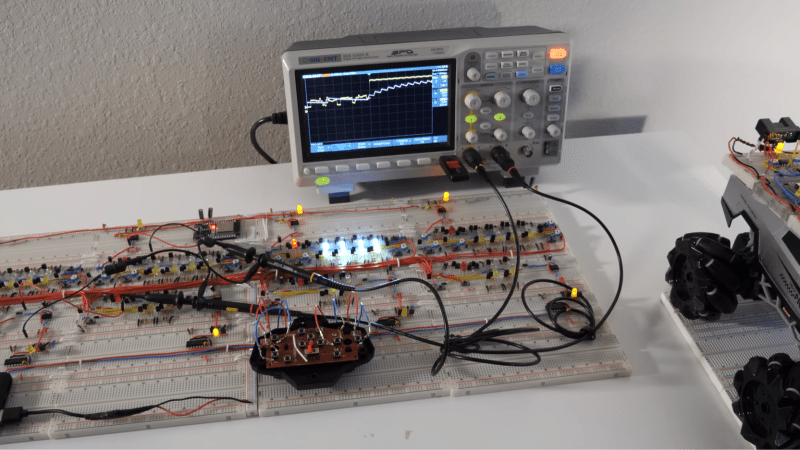Recently the [Global Science Network] released a video of using an artificial brain to control an RC truck.
The video shows a neural network comprised of eight artificial neurons assembled on breadboards used to control a fully autonomous toy truck. The truck is equipped with four proximity sensors, one front, one front left, one front right, and one rear. The sensor readings from the truck are transmitted to the artificial brain which determines which way to turn and whether to go forward or backward. The inputs to each neuron, the “synapses”, can be excitatory to increase the firing rate or inhibitory to decrease the firing rate. The output commands are then returned wirelessly to the truck via a hacked remote control.
This particular type of neural network is called a Spiking Neural Network (SNN) which uses discrete events, called “spikes”, instead of continuous real-valued activations. In these types of networks when a neuron fires matters as well as the strength of the signal. There are other videos on this channel which go into more depth on these topics.
The name of this experimental vehicle is the GSN SNN 4-8-24-2 Autonomous Vehicle, which is short for: Global Science Network Spiking Neural Network 4 Inputs 8 Neurons 24 Synapses 2 Degrees of Freedom Output. The circuitry on both the vehicle and the breadboards is littered with LEDs which give some insight into how it all functions.
If you’re interested in how neural networks can control behavior you might like to see a digital squid’s behavior shaped by a neural network.















lol :)
ok…….but how where the parameters set?
Manually! https://youtu.be/nL_UZBd93sw?t=438
Reminds me a bit of an old book, Braitenberg’s “Vehicles” (ISBN-13: 978-0262521123), in which a series of primitive hypothetical nervous systems are explored. The creatures are entirely abstract/artificial constructs. The first one, if I recall, had just one sensor and one motor. Anyway, might be a source of ideas to try out with this physically real system.
Thanks for the tip. I was researching and I found this: https://www.amazon.com/dp/0262548194 — and the book itself can still be found: https://www.amazon.com/dp/0262022087
doh. I was working on my own SNN project, but using TTL gates instead. This one is clearly better since it works on the transistor level instead. well, I guess a big drawback is that you can’t easily change the weights of each input or the inhibitory signals. Mine can load the weights through a single serial chain, so I guess there’s still merit to developing it. But this will be a great reference.
I am glad this will be a useful reference for you. If you get your SNN working be sure to write it up and send it in so we can cover it!
Wow, i was thinking one can not do such things with less Neurons than caenorhabditis elegans [1,2]. But i seem to be wrong … this Study also talks about that the worm has also one neuron for the forward gear / forward command neuron.
Project is in my opinion of pedagogical worth because it demystifies neuronal networks.
Q: do you prefer Daniel Dennets theory OR David Calmers theory ???
[1] http://browser.openworm.org
[2] https://journals.plos.org/ploscompbiol/article?id=10.1371%2Fjournal.pcbi.1001066
Hi Marc, thanks for your note. I love the phrase “hard problem of consciousness” but at the end of the day I support Dennett’s theory more so than Chalmers’. I believe consciousness is an emergent phenomena from physicality, not some sort of substance. But it does seem very strange that we have this sort of real experience of consciousness, it remains a hard problem, particularly why it should be that way at all.
Stick some Piezo elements on so you can hear it thinking too.
BEAM robotics lives again. There were a few BEAM hobbyists who experimented with SSNs back in the 90s/early 2000s before the movement petered out.